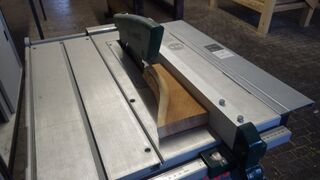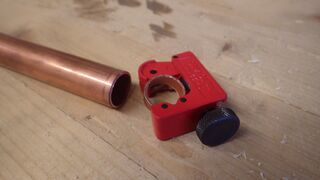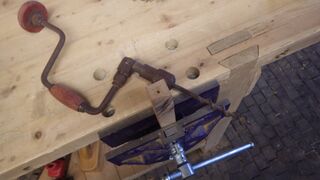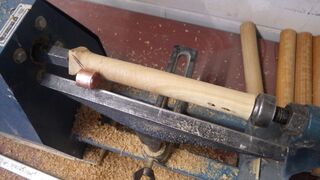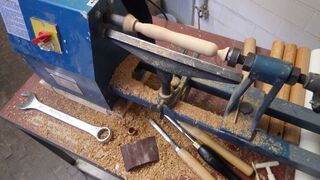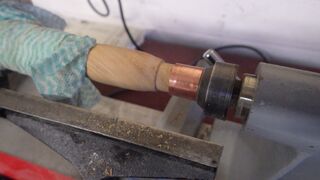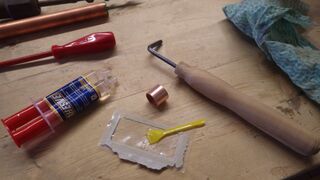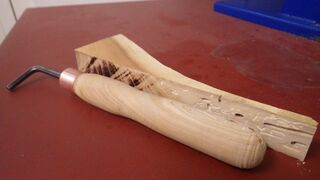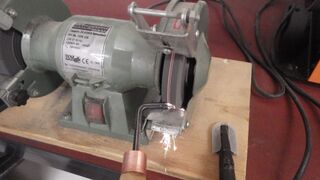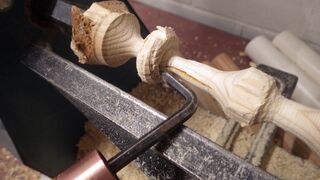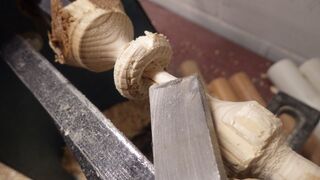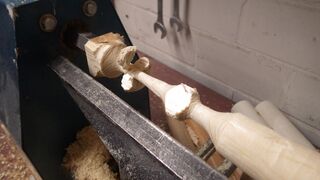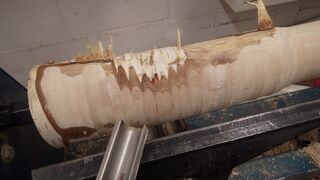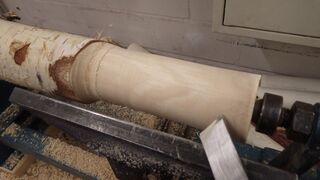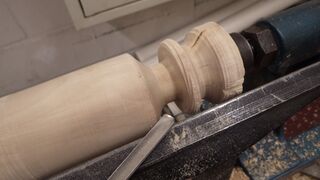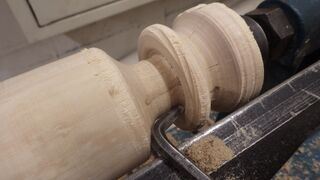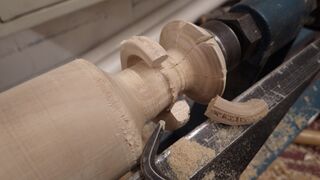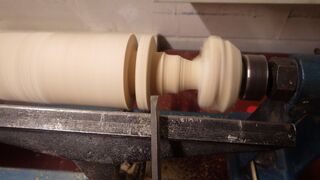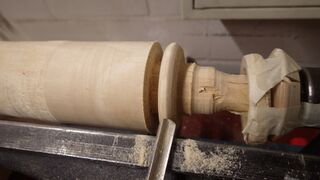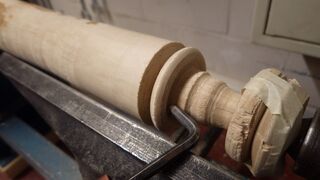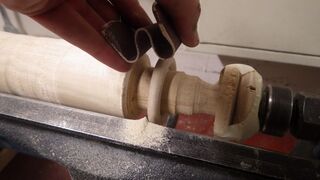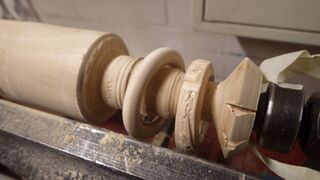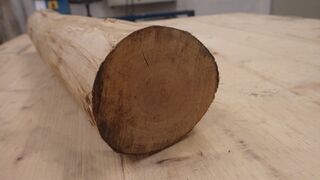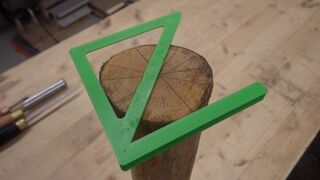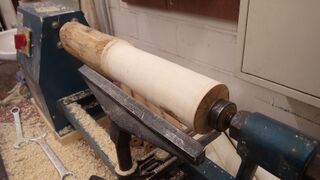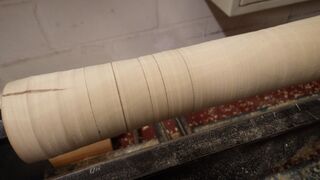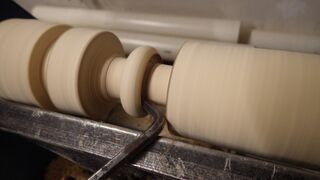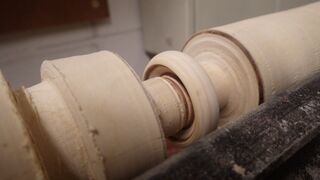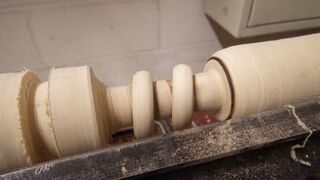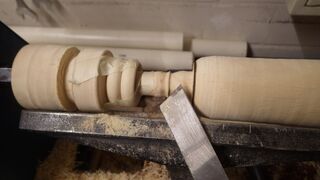Project:Captive Ring Turning: Difference between revisions
(first gallery up) |
(→Baby Rattle: more photos) |
||
| (4 intermediate revisions by the same user not shown) | |||
| Line 1: | Line 1: | ||
{{ProjectInfoBox | {{ProjectInfoBox | ||
|project title=Captive Ring Baby Rattle | |project title=Captive Ring Baby Rattle | ||
|image= | |image=captive rings - test13.JPG | ||
|status=done, now adding photos | |status=done, now adding photos | ||
|date=March 2019 | |date=March 2019 | ||
|initiator=[[Lukas]] | |initiator=[[Lukas]] | ||
|materials=[[wood]] (apple log, [[Project:Drying Timber|self-dried]]), [[beeswax]] | |materials=[[wood]] (apple log, [[Project:Drying Timber|self-dried]]), [[beeswax]] | ||
|tools=[[Woodturning Tools|woodturning tools]]: | |tools=[[Woodturning Tools|woodturning tools]]: | ||
| Line 12: | Line 11: | ||
* [[Spindle Gouge|spindle gouge]] | * [[Spindle Gouge|spindle gouge]] | ||
* [[Hook Tool|hook tool]] | * [[Hook Tool|hook tool]] | ||
|cost=next to nothing | |cost=next to nothing | ||
}} | }} | ||
| Line 18: | Line 16: | ||
I taught myself how to do it in order to make a one-piece rattle for some awesome babies! | I taught myself how to do it in order to make a one-piece rattle for some awesome babies! | ||
== tl;dr == | |||
* hard wood | |||
* patience | |||
* shape & sand as much as you can before "freeing" the ring | |||
* expect some burn marks | |||
== Choosing the Material == | == Choosing the Material == | ||
You'll need especially even-grained and dense wood for this project or the rings are prone to breaking. | You'll need especially even-grained and dense wood for this project or the rings are prone to breaking. | ||
I was very happy with the '''apple''' log I had laid aside for this project all along, but the birch I used as | I was very happy with the '''apple''' log I had laid aside for this project all along, but the birch and especially fir that I used as first tests behaved pretty badly. | ||
<br clear=right> | <br clear=right> | ||
== Making the Hook Tool == | == Making the Hook Tool == | ||
First of all, I made the special tool needed to undercut the rings. There are commercial "ring" or "hook" tools available but I had [[YouTube Makers|seen]] DIY versions made from [[Hex Keys|hex keys]] and obviously just had to try that! | First of all, I made the special tool needed to undercut the rings. There are commercial "ring" or "hook" tools available but I had [[YouTube Makers|seen]] DIY versions made from [[Hex Keys|hex keys]] and obviously just had to try that! | ||
| Line 42: | Line 47: | ||
File:hook tool 8.JPG|amazing what you can still make out of a little bit of junk! (rest of the [[Scrap Wood|scrap wood]] for comparison) | File:hook tool 8.JPG|amazing what you can still make out of a little bit of junk! (rest of the [[Scrap Wood|scrap wood]] for comparison) | ||
File:hook tool 9.JPG|finally grind a scraping tip onto the (former) hex key | File:hook tool 9.JPG|finally grind a scraping tip onto the (former) hex key | ||
</gallery> | |||
== Educative Failures == | |||
<gallery mode=packed widths=200 caption="first attempt: scrap fir wood"> | |||
File:captive rings - test01.JPG | |||
File:captive rings - test02.JPG | |||
File:captive rings - test03.JPG | |||
</gallery> | |||
<center>'''lessons learned:''' wood too soft, piece too thin</center> | |||
<gallery mode=packed widths=200 caption="next try: birch (poor quality)"> | |||
File:captive rings - test04.JPG | |||
File:captive rings - test05.JPG | |||
File:captive rings - test06.JPG | |||
File:captive rings - test07.JPG | |||
File:captive rings - test08.JPG | |||
File:captive rings - test09.JPG | |||
File:captive rings - test10.JPG | |||
File:captive rings - test11.JPG | |||
File:captive rings - test12.JPG | |||
File:captive rings - test13.JPG | |||
</gallery> | |||
<center>'''lessons learned:''' wood still a bit too soft, [[Parting Tool|parting tool]] much more suitable to define the ring width than [[Spindle Gouge|spindle gouge]], poor bevel on the hook tool, use even less force than usual</center> | |||
The second birch ring turned out a lot better than the first so I decided to get serious! | |||
== Baby Rattle == | |||
<gallery mode=packed widths=200 caption="the final piece :-)"> | |||
File:captive rings 01.JPG|the apple log [[Project:Drying Timber|was dried]] quite nicely and only had two superficial cracks | |||
File:Center finder on log.JPG|tried to find the center as closely as possible to the log would rotate nicely and not lose too much material | |||
File:captive rings 03.JPG|first step in pretty much any [[woodturning]] project: roughing | |||
File:captive rings 04.JPG|sketching the dimensions of the first elements: end knob, gap, ring (1/2 gap width), gap | |||
File:captive rings 05.JPG|after defining its outer curve with a [[Parting Tool|parting tool]] and then a [[Spindle Gouge|spindle gouge]], the future ring is slowly undercut with the [[Hook Tool|hook tool]] | |||
File:captive rings 06.JPG|burn marks are to be expected when using a [[Self-Made Tools|self-made tool]] for this job - just make sure you don't generate enough heat to crack the wood! | |||
File:captive rings 07.JPG|fast forward: two rings are cut! See "[[#Educative Failures|educative failures]]" above for more details on this part of the project | |||
File:captive rings 08.JPG|this part was a bit scary (not tested beforehand): "planing" the middle section with the [[Skew Chisel|skew chisel]] while the rings are taped to the side | |||
</gallery> | </gallery> | ||
Revision as of 15:22, 13 July 2019
| ProjectInfoBox Captive Ring Baby Rattle | |
|---|---|
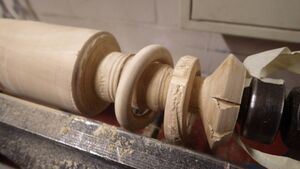
| |
| Status: | done, now adding photos |
| Release Date: | March 2019 |
| Initiator: | Lukas |
| Materials Used: | wood (apple log, self-dried), beeswax |
| Tools Used: | woodturning tools: |
| Approx. Cost: | next to nothing |
Turning "captive rings" is a tricky technique, but tried by many woodturners at some point.
I taught myself how to do it in order to make a one-piece rattle for some awesome babies!
tl;dr
- hard wood
- patience
- shape & sand as much as you can before "freeing" the ring
- expect some burn marks
Choosing the Material
You'll need especially even-grained and dense wood for this project or the rings are prone to breaking.
I was very happy with the apple log I had laid aside for this project all along, but the birch and especially fir that I used as first tests behaved pretty badly.
Making the Hook Tool
First of all, I made the special tool needed to undercut the rings. There are commercial "ring" or "hook" tools available but I had seen DIY versions made from hex keys and obviously just had to try that!
Materials:
- scrap wood (hardwood - here: cherry)
- surplus large hex key
square up the woodturning blank
the first step of most tool handle woodturning projects is the ferrule - e.g. cut with a pipe cutter
a brace is very useful to pre-drill the center hole on a woodturning blank
make the handle rather long - like all woodturning tools, it should provide good leverage
a sturdy tailstock on the wood lathe can help to press the ferrule onto the tool handle
the hex key and ferrule should be glued in place with epoxy
amazing what you can still make out of a little bit of junk! (rest of the scrap wood for comparison)
Educative Failures
- first attempt: scrap fir wood
- next try: birch (poor quality)
The second birch ring turned out a lot better than the first so I decided to get serious!
Baby Rattle
- the final piece :-)
the apple log was dried quite nicely and only had two superficial cracks
first step in pretty much any woodturning project: roughing
after defining its outer curve with a parting tool and then a spindle gouge, the future ring is slowly undercut with the hook tool
burn marks are to be expected when using a self-made tool for this job - just make sure you don't generate enough heat to crack the wood!
fast forward: two rings are cut! See "educative failures" above for more details on this part of the project
this part was a bit scary (not tested beforehand): "planing" the middle section with the skew chisel while the rings are taped to the side
more coming soon!
